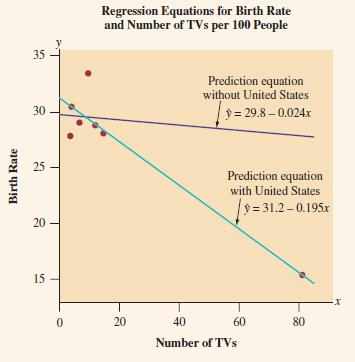TV watching and the birth rate The figure shows recent data on x = the number of
Question:
TV watching and the birth rate The figure shows recent data on x = the number of televisions per 100 people and y = the birth rate (number of births per 1000 people) for six African and Asian nations. The regression line, yn = 29.8
- 0.024x, applies to the data for these six countries. For illustration, another point is added at (81, 15.2), which is the observation for the United States. The regression line for all seven points is yn = 31.2
- 0.195x. The figure shows this line and the one without the U.S. observation.
a. Does the U.S. observation appear to be (i) an outlier on x, (ii) an outlier on y, or (iii) a regression outlier relative to the regression line for the other six observations?
b. State the two conditions under which a single point can have a dramatic effect on the slope and show that they apply here.
c. This one point also drastically affects the correlation, which is r = -0.051 without the United States but r = -0.935 with the United States. Explain why you would conclude that the association between birth rate and number of televisions is (i) very weak without the U.S. point and (ii) very strong with the U.S. point.
d. Explain why the U.S. residual for the line fitted using that point is very small. This shows that a point can be influential even if its residual is not large.

Step by Step Answer:

Statistics The Art And Science Of Learning From Data
ISBN: 9781292164878
4th Global Edition
Authors: Alan Agresti, Christine A. Franklin, Bernhard Klingenberg






